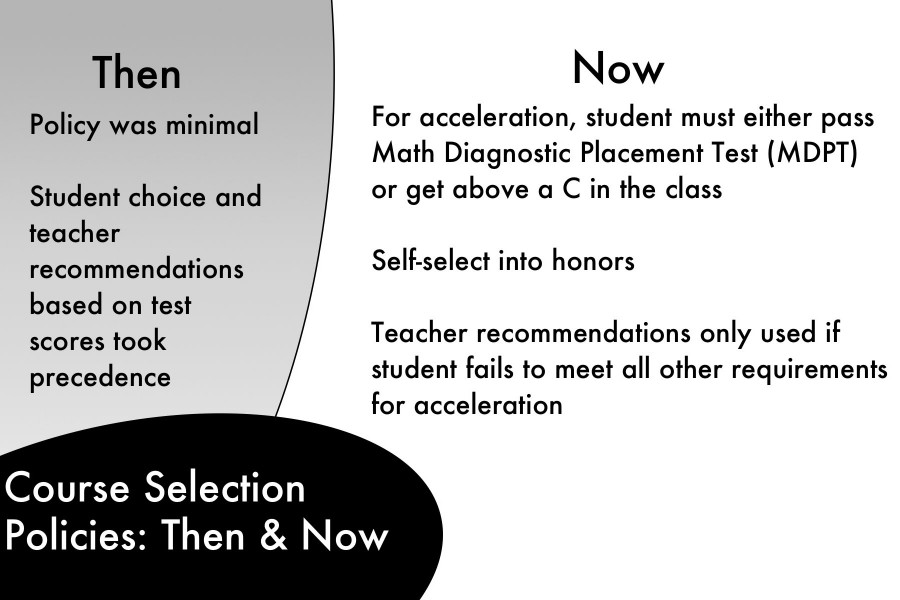District approves math placement rules
While teacher recommendation and student choice previously decided math placement for incoming freshmen, new administrative regulations passed by the MVLA School Board on February 8 created a framework for a more objective policy, where teacher recommendations may only accelerate an eighth grader into a higher level course.
The regulations outline two ways for students to progress to the next course. They can either achieve a C or above in their eighth grade math class or meet a minimum score on the Math Diagnostic Testing Project (MDTP), designed by the California State University and University of California to assess algebra foundations.
To Superintendent Jeff Harding, the regulations help address the discrepancy of placement into higher level math courses between students from low and high socioeconomic backgrounds.
“This [policy] is about equity,” Harding said. “Our intention is to try to give students from a low socioeconomic [status] equal footing, equal opportunity as students from wealthy families, who have parents standing up for them.”
The policy attempts to reduce the likelihood of students falling into remedial classes, using a system that provides students multiple chances to move to the next course. Teacher recommendations can no longer push students to lower classes, and can instead only be used to accelerate students.
For students in regular or support course tracks, math class often holds the role of a “gatekeeper course,” as students who do not meet necessary course requirements are unable to meet qualifications for the University of California and other colleges.
“Math tends to be a gatekeeper course,” Harding said. “What I mean by gatekeeper course is that it tends to be a barrier to students in terms of going to college, [because if] you don’t take Algebra II, you don’t get in.”
In April, all feeder middle schools will begin to administer the MDTP to eighth grade students. The test is designed to evaluate students in their mastery of algebraic concepts, while providing another opportunity for students to advance to the succeeding math class.
“Sometimes students do not like the teacher, or maybe the student doesn’t do homework… but they understand the topic very well,” Harding said. “If they pass the [MDTP] and show that they’re ready for the next level, this gives them another option to get into the next course.”
The regulations stem from a complaint in August 2015 filed by the Lawyers’ Committee for Civil Rights (LCCR), an organization that works to promote minority rights, which took issue with MVLA’s lack of a clear placement policy. The previous open enrollment system, according to the LCCR, was susceptible to factors that hurt minorities and students of low socioeconomic status.
“Reliance on subjective factors allows for the unconscious bias and stereotyping to influence teachers’ recommendations regarding math placement,” the LCCR complaint said. “Teachers may encourage minority students to repeat a class that they have completed successfully… because of implicit biases regarding what students of particular races are capable of achieving.”
Controversies arose over the legitimacy of the LCCR’s claims, as district members argue that the data used in the report was taken out of context and without explanation. The statistics, which showed that fewer minority students advanced to algebra from geometry in ninth grade, did not differentiate between different algebra classes.
“They took any course that had the word ‘algebra’ in the title and counted it as algebra,” Blach math teacher Marcia Chron said. “They noticed that it looked like some kids were retaking the same class that they had just passed the year before. In actuality, they took things like ‘algebra readiness,’ ‘pre-algebra,’ and… counted [them] as algebra, so obviously it looked like they were repeating the class.”
Whether the allegations are backed by evidence or not, the policy ensures that math placement is not a hindrance to minority students and those of lower socioeconomic status who may not always be pushed to the next math level.
“The LCCR wrote a report that said basically [math placement] is a civil rights issue,” Harding said. “They said our former [placement methods] were biased against [students of] low socioeconomic [status]. Now it’s debatable whether that’s the case, and I don’t think anyone ever intentionally held students back, but now we have a policy that ensures that students move forward.”





